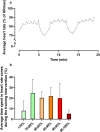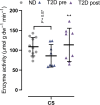Skeletal muscle proteins important for work capacity are altered with type 2 diabetes - Effect of 10-20-30 training
- PMID: 33426802
- PMCID: PMC7797308
- DOI: 10.14814/phy2.14681
Skeletal muscle proteins important for work capacity are altered with type 2 diabetes - Effect of 10-20-30 training
Abstract
The study examined whether men with type 2 diabetes exhibit lower expression of muscle proteins important for exercise capacity, and whether exercise training promotes adaptations in these proteins. In a cross-sectional and longitudinal study, conducted at the University of Copenhagen. Twelve men with type 2 diabetes (T2D) were compared to eleven nondiabetes counterparts (ND) matched for age and body composition (body fat percentage). T2D underwent 10 weeks of high-intensity interval exercise training (10-20-30 training). T2D had lower expression of SOD1 (-62%; p < 0.001) and ETC complex V (-34%; p = 0.003), along with higher expression of ETC complex IV (+66%; p = 0.007), MFN2 (+62%; p = 0.001), and DRP1 (+30%; p = 0.028) compared to ND. T2D had higher (p < 0.001) expression of Na+ /K+ α1 (+98%), α2 (+114%), and NHE1 (+144%) than ND. In T2D, training increased exercise capacity (+9%; p < 0.001) as well as expression of SOD2 (+44%; p = 0.029), ETC complex II (+25%; p = 0.035), III (+52%; p = 0.041), IV (+23%; p = 0.005), and V (+21%; p = 0.035), CS activity (+32%; p = 0.006) as well as Na+ /K+ α1 (+24%; p = 0.034), Kir6.2 (+36%; p = 0.029), and MCT1 (+20%; p = 0.007). Men with type 2 diabetes exhibited altered expression of a multitude of skeletal muscle proteins important for exercise capacity. Ten weeks of 10-20-30 training upregulated expression of muscle proteins regulating antioxidant defense, mitochondrial function, and ion handling while enhancing exercise capacity in men with type 2 diabetes.
Trial registration: ClinicalTrials.gov NCT03349944.
Keywords: antioxidant defense; high-intensity interval training; ion handling; mitochondria.
© 2021 The Authors. Physiological Reports published by Wiley Periodicals LLC on behalf of The Physiological Society and the American Physiological Society.
Figures








Similar articles
-
Superior mitochondrial adaptations in human skeletal muscle after interval compared to continuous single-leg cycling matched for total work.J Physiol. 2017 May 1;595(9):2955-2968. doi: 10.1113/JP272570. Epub 2016 Aug 3. J Physiol. 2017. PMID: 27396440 Free PMC article.
-
Leg vascular and skeletal muscle mitochondrial adaptations to aerobic high-intensity exercise training are enhanced in the early postmenopausal phase.J Physiol. 2017 May 1;595(9):2969-2983. doi: 10.1113/JP273871. Epub 2017 Mar 29. J Physiol. 2017. PMID: 28231611 Free PMC article. Clinical Trial.
-
Preservation of skeletal muscle mitochondrial content in older adults: relationship between mitochondria, fibre type and high-intensity exercise training.J Physiol. 2017 Jun 1;595(11):3345-3359. doi: 10.1113/JP273950. Epub 2017 Apr 23. J Physiol. 2017. PMID: 28251664 Free PMC article.
-
Physiological adaptations to interval training and the role of exercise intensity.J Physiol. 2017 May 1;595(9):2915-2930. doi: 10.1113/JP273196. Epub 2016 Dec 7. J Physiol. 2017. PMID: 27748956 Free PMC article. Review.
-
Insulin regulation of mitochondrial proteins and oxidative phosphorylation in human muscle.Trends Endocrinol Metab. 2003 Nov;14(9):393-4. doi: 10.1016/j.tem.2003.09.002. Trends Endocrinol Metab. 2003. PMID: 14580754 Review.
Cited by
-
Effects of floorball and strength training in a real-life setting on health and physical function in older men.Front Aging. 2025 Jul 25;6:1574084. doi: 10.3389/fragi.2025.1574084. eCollection 2025. Front Aging. 2025. PMID: 40787248 Free PMC article.
-
10-20-30 exercise training improves fitness and health.Eur J Sport Sci. 2024 Aug;24(8):1162-1175. doi: 10.1002/ejsc.12163. Epub 2024 Jul 19. Eur J Sport Sci. 2024. PMID: 39031952 Free PMC article. Review.
References
-
- Allen, D. G. , Lamb, G. D. , & Westerblad, H. (2008). Skeletal muscle fatigue: cellular mechanisms. Physiological Reviews, 88(1), 287–332. - PubMed
-
- Aouacheri, O. , Saka, S. , Krim, M. , Messaadia, A. , & Maidi, I. (2015). The investigation of the oxidative stress‐related parameters in type 2 diabetes mellitus. Canadian Journal of Diabetes, 39(1), 44–49. - PubMed
-
- Baasch‐Skytte, T. , Lemgart, C. T. , Oehlenschlager, M. H. , Petersen, P. E. , Hostrup, M. , Bangsbo, J. , & Gunnarsson, T. P. (2020). Efficacy of 10–20‐30 training versus moderate‐intensity continuous training on HbA1c, body composition and maximum oxygen uptake in male patients with type 2 diabetes: A randomized controlled trial. Diabetes, Obesity & Metabolism, 22(5). - PubMed
-
- Bach, D. , Naon, D. , Pich, S. , Soriano, F. X. , Vega, N. , Rieusset, J. , Laville, M. , Guillet, C. , Boirie, Y. , Wallberg‐Henriksson, H. , Manco, M. , Calvani, M. , Castagneto, M. , Palacín, M. , Mingrone, G. , Zierath, J. R. , Vidal, H. , & Zorzano, A. (2005). Expression of Mfn2, the Charcot‐Marie‐Tooth neuropathy type 2A gene, in human skeletal muscle: effects of type 2 diabetes, obesity, weight loss, and the regulatory role of tumor necrosis factor alpha and interleukin‐6. Diabetes, 54(9), 2685–2693. - PubMed
-
- Baldi, J. C. , Aoina, J. L. , Oxenham, H. C. , Bagg, W. , & Doughty, R. N. (2003). Reduced exercise arteriovenous O2 difference in Type 2 diabetes. Journal of Applied Physiology, 94(3), 1033–1038. - PubMed
Publication types
MeSH terms
Substances
Associated data
LinkOut - more resources
Full Text Sources
Other Literature Sources
Medical
Miscellaneous

